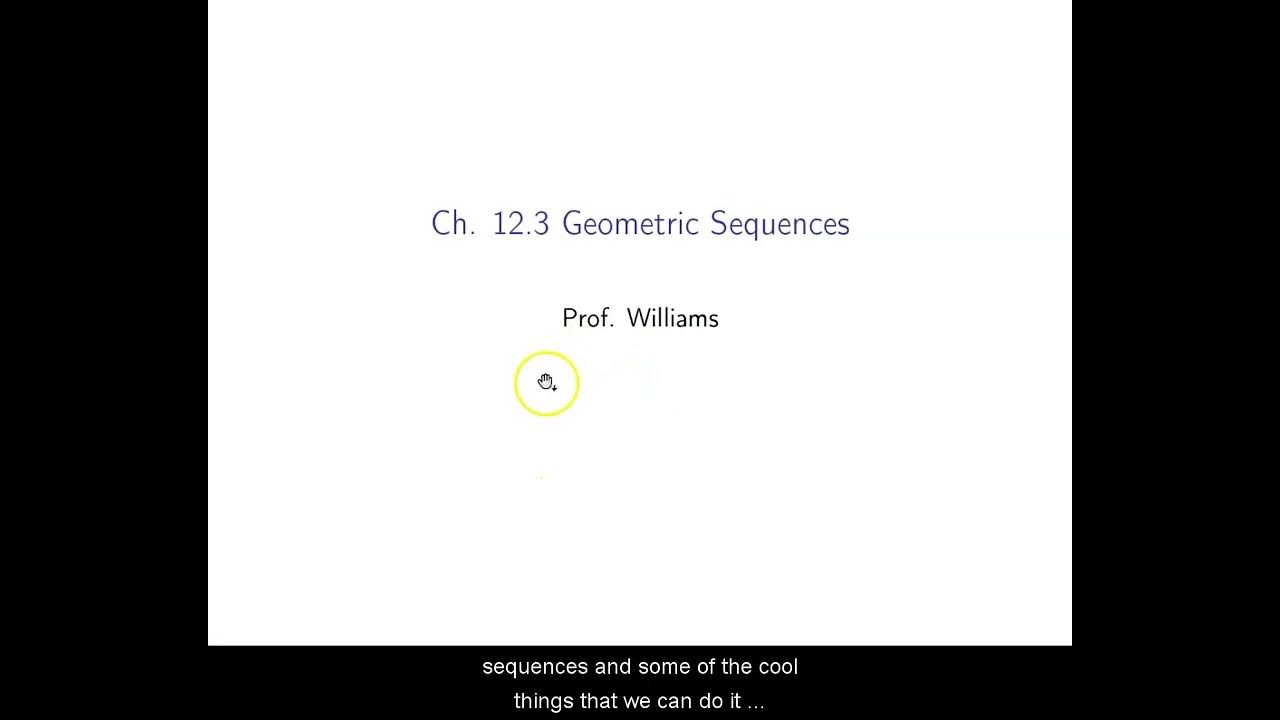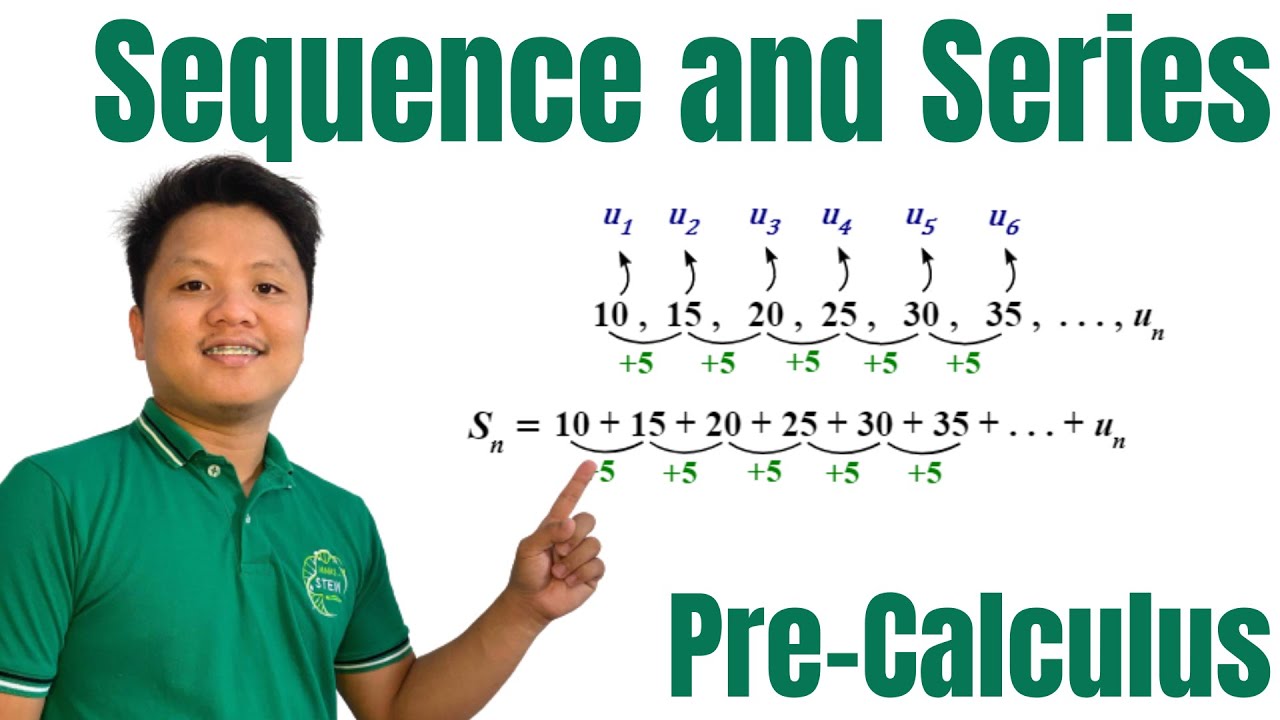Geometric Sequences (Precalculus - College Algebra 71)
TLDRThis video script delves into the concept of geometric sequences and series, contrasting them with arithmetic sequences. It explains that while arithmetic sequences are formed by adding a constant difference between successive terms, geometric sequences are created by multiplying a common ratio. The script outlines how to identify a geometric sequence by dividing consecutive terms and finding the consistent common ratio. It also provides a formula for finding any term in a geometric sequence, emphasizing the 'n minus 1' aspect, which accounts for the starting term. The video further illustrates the process with various examples, showing how to determine if a sequence is arithmetic, geometric, or neither, and how to derive the formula for a geometric sequence when given certain terms or the common ratio. It concludes by setting the stage for the next video, which will cover geometric series, including convergence and divergence.
Takeaways
- 📐 **Geometric Sequences Defined**: A sequence where each term after the first is found by multiplying the previous term by a fixed, non-zero number called the common ratio (r).
- 🔢 **Common Ratio (r)**: The constant multiplier used to generate each term in a geometric sequence, found by dividing any term by its preceding term.
- 🚫 **Not Arithmetic**: Geometric sequences differ from arithmetic sequences, which involve adding a common difference (d) rather than multiplying by a common ratio.
- ➗ **Identifying Geometric Sequences**: To confirm a sequence is geometric, divide successive terms and ensure the quotient is constant, indicating the common ratio.
- 🔁 **Sequence Formula**: The general form of a geometric sequence is a_n = a_1 \cdot r^{(n-1)}, where a_1 is the first term, r is the common ratio, and n is the term number.
- 🔑 **Finding Terms**: Any term in a geometric sequence can be found using the formula by substituting the term's position for n.
- 🔍 **Sequence Recognition**: To identify if a sequence is geometric, check if multiplying by the common ratio consistently progresses through the sequence.
- 📉 **Negative Ratios**: Geometric sequences can have negative common ratios, resulting in alternating signs of terms.
- 🔠 **Non-Geometric Patterns**: Some sequences may have a pattern but do not fit the arithmetic or geometric models, such as adding successive integers.
- 🧮 **Arithmetic vs. Geometric**: Determine the type of sequence by testing for a common difference in arithmetic sequences or a common ratio in geometric sequences.
- ⛓ **Sequence Consistency**: For a sequence to be classified as arithmetic or geometric, it must maintain the same pattern throughout; a sequence cannot switch between the two.
Q & A
What is the key difference between an arithmetic sequence and a geometric sequence?
-The key difference is that in an arithmetic sequence, each term is obtained by adding a constant number (common difference) to the previous term, whereas in a geometric sequence, each term is obtained by multiplying the previous term by a constant number (common ratio).
How do you identify if a sequence is geometric?
-To identify if a sequence is geometric, divide any two successive terms. If the resulting quotient is the same for all pairs of successive terms, then the sequence is geometric.
What is the common ratio in a geometric sequence?
-The common ratio in a geometric sequence is the constant number by which each term is obtained by multiplying the previous term.
How can you find the nth term of a geometric sequence if you know the first term and the common ratio?
-The nth term of a geometric sequence can be found using the formula: a_n = a_1 * r^(n-1), where a_n is the nth term, a_1 is the first term, r is the common ratio, and n is the term number.
What is the difference between the common difference in an arithmetic sequence and the common ratio in a geometric sequence?
-The common difference in an arithmetic sequence is the constant value added to each term to get the next term, while the common ratio in a geometric sequence is the constant value by which each term is multiplied to get the next term.
How can you determine if a sequence is arithmetic or geometric by using the terms provided in the sequence?
-To determine if a sequence is arithmetic, subtract successive terms and check for a common difference. For a geometric sequence, divide successive terms and check for a common ratio.
What happens if the sequence does not follow a constant pattern of addition or multiplication?
-If a sequence does not follow a constant pattern of addition or multiplication, it is neither an arithmetic sequence nor a geometric sequence.
What is the formula for the nth term of a geometric sequence?
-The formula for the nth term of a geometric sequence is a_n = a_1 * r^(n-1), where a_n is the nth term, a_1 is the first term, and r is the common ratio.
Why is the exponent (n-1) used in the formula for the nth term of a geometric sequence?
-The exponent (n-1) is used because it represents the number of times the common ratio must be multiplied by the first term to reach the nth term, considering that the first term itself does not require multiplication.
How can you find the first term of a geometric sequence if you know a specific term and the common ratio?
-If you know a specific term and the common ratio, you can find the first term by using the formula for the nth term and solving for a_1, considering the known term as a_n and the position of that term as n.
What is the significance of the term 'convergence' in the context of geometric series?
-Convergence refers to the property of a geometric series where the sum of the series approaches a finite value as the number of terms increases. This is dependent on the common ratio of the series.
Outlines
😀 Introduction to Geometric Sequences
The video begins by transitioning from arithmetic sequences and series to geometric ones. It explains that geometric sequences differ from arithmetic ones in that they involve multiplying by a constant, known as the common ratio, rather than adding a constant difference. The video promises to cover how to identify and formulate geometric sequences and series, and to discuss their convergence or divergence in a subsequent video.
🔢 Identifying Arithmetic vs. Geometric Sequences
This paragraph delves into how to distinguish between arithmetic and geometric sequences. It provides examples and shows that while arithmetic sequences are identified by a common difference between successive terms, geometric sequences are characterized by a common ratio obtained by dividing any two successive terms. The video script includes examples to illustrate the process of determining whether a given sequence is arithmetic, geometric, or neither.
📊 The Formula for Geometric Sequences
The script explains the formula for a geometric sequence, emphasizing the importance of knowing the first term and the common ratio. It illustrates how to find any term in the sequence by multiplying the first term by the common ratio raised to the power of (n - 1), where n is the term number. The paragraph also provides an example using the formula to find specific terms in a sequence.
🤔 Determining Geometric Sequences with Given Terms
This section discusses how to handle geometric sequences when the first term is not given but other terms and the common ratio are known. It demonstrates using the geometric sequence formula to find the first term when one or more terms are provided. The video script includes a step-by-step process for solving for the first term and common ratio when only certain terms of the sequence are known.
🔁 Finding the Common Ratio and First Term
The paragraph explores scenarios where the common ratio is not directly given and shows methods to find it. It describes setting up equations based on known terms and the sequence formula, then solving these equations to find the missing first term and common ratio. The video script provides a clear example of how to solve for these unknowns using algebraic manipulation.
🌟 Simplifying Geometric Sequences
The final paragraph of the script touches on simplifying geometric sequences, particularly when the first term can be expressed as a power of the common ratio. It explains the concept of negative exponents and how they can be used to alter the formula to an n minus 2 form. The video concludes with a summary of how to identify and formulate geometric sequences and a teaser for the next topic: geometric series.
🏁 Conclusion and Transition to Geometric Series
This paragraph serves as a conclusion to the discussion on geometric sequences and a transition to the next topic, which is geometric series. It reiterates the key points about geometric sequences and hints at the upcoming content on how to sum these sequences, including the concepts of convergence and divergence.
Mindmap
Keywords
💡Geometric Sequence
💡Common Ratio (r)
💡Arithmetic Sequence
💡Convergence and Divergence
💡Geometric Series
💡nth Term
💡Series Summation
💡Common Difference (d)
💡Sequence Classification
💡Formula Manipulation
💡Linear Common Difference
Highlights
A geometric sequence is a sequence where each term is found by multiplying the previous term by a constant, known as the common ratio.
The common ratio (r) of a geometric sequence is determined by dividing any term by its preceding term.
A geometric sequence can be identified by checking if the ratio between successive terms is constant throughout the sequence.
The formula for the nth term of a geometric sequence is given by a_sub_1 * r^(n-1), where a_sub_1 is the first term.
The difference between arithmetic and geometric sequences is that arithmetic sequences involve adding a constant difference, while geometric sequences involve multiplying by a constant ratio.
If a sequence is not arithmetic, it might still be geometric if the multiplication factor between successive terms is constant.
Geometric sequences can be represented using the formula a_n = a_sub_1 * r^(n-1), where a_n is the nth term.
To determine if a given sequence is geometric, divide successive terms and check for a consistent result, which would be the common ratio.
The video provides a method to find the nth term of a geometric sequence using the common ratio and the first term of the sequence.
An example is given where the sixth term of a sequence is known, and the video demonstrates how to find the first term and the common ratio.
The video explains how to handle sequences where the common ratio is not explicitly given and requires setting up equations to solve for it.
A geometric sequence can be manipulated to express it in a more concise form, such as changing the exponent from n-1 to n-2 in certain cases.
The concept of the common ratio being a negative number is explored, with examples showing how to handle such sequences.
The video emphasizes the importance of checking all pairs of successive terms to confirm if a sequence is geometric or arithmetic.
A sequence that does not fit the pattern of either arithmetic or geometric is considered to be neither, as it does not maintain a constant operation between terms.
The video concludes with a summary of how to identify and work with geometric sequences, including finding specific terms and the common ratio.
Transcripts
Browse More Related Video

ILLUSTRATING SEQUENCES AND SERIES || PRECALCULUS

Arithmetic Sequences (Precalculus - College Algebra 69)

Ch. 12.3 Geometric Sequences

Geometric Series (Precalculus - College Algebra 72)

Sequence and Series | Terms of Sequence and Associated Series | Pre-Calculus

Geometric Sequence Calculator Techniques - Engr. Yu Jei Abat | AbatAndChill
5.0 / 5 (0 votes)
Thanks for rating: